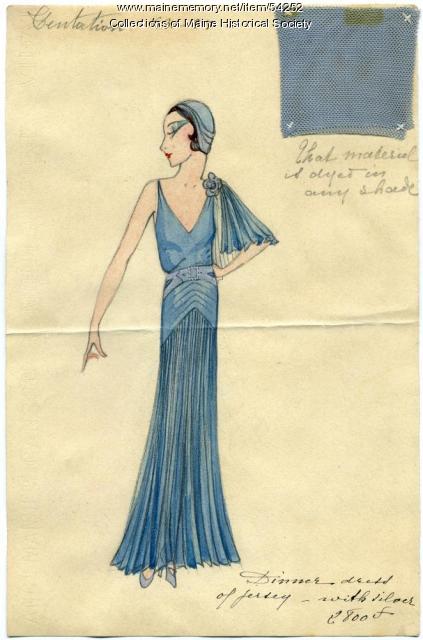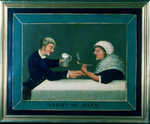Keywords: Park Papers
- Historical Items (84)
- Tax Records (303)
- Architecture & Landscape (81)
- Online Exhibits (31)
- Site Pages (27)
- My Maine Stories (2)
- Lesson Plans (0)
Online Exhibits
Your results include these online exhibits. You also can view all of the site's exhibits, view a timeline of selected events in Maine History, and learn how to create your own exhibit. See featured exhibits or create your own exhibit
Exhibit
Paper has shaped Maine's economy, molded individual and community identities, and impacted the environment throughout Maine. When Hugh Chisholm opened the Otis Falls Pulp Company in Jay in 1888, the mill was one of the most modern paper-making facilities in the country, and was connected to national and global markets. For the next century, Maine was an international leader in the manufacture of pulp and paper.
Exhibit
From Sewers to Skylines: William S. Edwards's 1887 Photo Album
William S. Edwards (1830-1918) was a civil engineer who worked for the City of Portland from 1876-1906. Serving as First Assistant to Chief Engineer William A. Goodwin, then to Commissioner George N. Fernald, Edwards was a fixture in City Hall for 30 consecutive years, proving indispensable throughout the terms of 15 Mayors of Portland, including all six of those held by James Phineas Baxter. Edwards made significant contributions to Portland, was an outstanding mapmaker and planner, and his works continue to benefit historians.
Exhibit
Washington County Through Eastern's Eye
Images taken by itinerant photographers for Eastern Illustrating and Publishing Company, a real photo postcard company, provide a unique look at industry, commerce, recreation, tourism, and the communities of Washington County in the early decades of the twentieth century.
Exhibit
These stories -- that stretch from 1999 back to 1759 -- take you from an amusement park to the halls of Congress. There are inventors, artists, showmen, a railway agent, a man whose civic endeavors helped shape Portland, a man devoted to the pursuit of peace and one known for his military exploits, Maine's first novelist, a woman who recorded everyday life in detail, and an Indian who survived a British attack.
Exhibit
Cosmopolitan stylings of Mildred and Madeleine Burrage
Born in Portland, sisters Mildred Giddings Burrage (1890-1983) and Madeleine Burrage (1891-1976) were renowned artists and world travelers. Mildred's experiences studying painting in Paris and Italy, and the sisters' trips to Mexico and Guatemala inspired their artwork and shared passions for cosmopolitan and stylish attire. Housed at Maine Historical Society, The Burrage Papers include selections of original advertising drawings called "line sheets" from Parisian fashion houses dating from 1928 to 1936. Images of Madeleine's gemstone jewelry and Mildred's artwork accompany intimate family photographs of the sisters.
Exhibit
A Portland newspaper wrote about an ice storm of January 28, 1886 saying, "The city of Portland was visited yesterday by the most inconvenient storm of the season."
Exhibit
Maine has some 17 million acres of forest land. But even on a smaller, more local scale, trees have been an important part of the landscape. In many communities, tree-lined commercial and residential streets are a dominant feature of photographs of the communities.
Exhibit
From the last decades of the nineteenth century through about the 1920s, vacationers were attracted to large resort hotels that promised a break from the noise, crowds, and pressures of an ever-urbanizing country.
Exhibit
Maine Streets: The Postcard View
Photographers from the Eastern Illustrating and Publishing Co. of Belfast traveled throughout the state, especially in small communities, taking images for postcards. Many of these images, taken in the first three decades of the twentieth century, capture Main Streets on the brink of modernity.
Exhibit
Educating Oneself: Carnegie Libraries
Industrialist Andrew Carnegie gave grants for 20 libraries in Maine between 1897 and 1912, specifying that the town own the land, set aside funds for maintenance, have room to expand -- and offer library services at no charge.
Exhibit
Rum, Riot, and Reform - Taverns, People, and Scenes
"Plan of Ann (now Park) Street, Portland, ca. 1802Maine Historical Society Plan of Ann Street, Portland, ca."
Exhibit
CODE RED: Climate, Justice & Natural History Collections
Explore topics around climate change by reuniting collections from one of the nation's earliest natural history museums, the Portland Society of Natural History. The exhibition focuses on how museums collect, and the role of humans in creating changes in society, climate, and biodiversity.
Exhibit
Several Mainers have run for president or vice president, a number of presidents, past presidents, and future presidents have had ties to the state or visited here, and, during campaign season, many presidential candidates and their family members have brought their campaigns to Maine.
Exhibit
Young men and women in the 19th century often went away from home -- sometimes for a few months, sometimes for longer periods -- to attend academies, seminaries, or schools run by individuals. While there, they wrote letters home, reporting on boarding arrangements and coursework undertaken, and inquired about the family at home.
Exhibit
Maine's natural resources -- granite, limestone and slate in particular -- along with its excellent ports made it a leader in mining and production of the valuable building materials. Stone work also attracted numerous skilled immigrants.
Exhibit
In 1921, Guy Gannett purchased two competing Portland newspapers, merging them under the Portland Press Herald title. He followed in 1925 with the purchase the Portland Evening Express, which allowed him to combine two passions: photography and aviation.
Exhibit
Great Cranberry Island's Preble House
The Preble House, built in 1827 on a hilltop over Preble Cove on Great Cranberry Island, was the home to several generations of Hadlock, Preble, and Spurling family members -- and featured in several books.
Exhibit
Sagadahoc County through the Eastern Eye
The Eastern Illustrating and Publishing Company of Belfast, Maine. employed photographers who traveled by company vehicle through New England each summer, taking pictures of towns and cities, vacation spots and tourist attractions, working waterfronts and local industries, and other subjects postcard recipients might enjoy. The cards were printed by the millions in Belfast into the 1940s.
Exhibit
Maine Eats: the food revolution starts here
From Maine's iconic lobsters, blueberries, potatoes, apples, and maple syrup, to local favorites like poutine, baked beans, red hot dogs, Italian sandwiches, and Whoopie Pies, Maine's identity and economy are inextricably linked to food. Sourcing food, preparing food, and eating food are all part of the heartbeat of Maine's culture and economy. Now, a food revolution is taking us back to our roots in Maine: to the traditional sources, preparation, and pleasures of eating food that have sustained Mainers for millennia.
Exhibit
Gifts From Gluskabe: Maine Indian Artforms
According to legend, the Great Spirit created Gluskabe, who shaped the world of the Native People of Maine, and taught them how to use and respect the land and the resources around them. This exhibit celebrates the gifts of Gluskabe with Maine Indian art works from the early nineteenth to mid twentieth centuries.
Exhibit
Looking Out: Maine's Fire Towers
Maine, the most heavily forested state in the nation, had the first continuously operational fire lookout tower, beginning a system of fire prevention that lasted much of the twentieth century.
Exhibit
Lincoln County through the Eastern Eye
The Penobscot Marine Museum’s photography collections include nearly 50,000 glass plate negatives of images for "real photo" postcards produced by the Eastern Illustrating and Publishing Company of Belfast. This exhibit features postcards from Lincoln County.
Exhibit
The history of the region now known as Maine did not begin at statehood in 1820. What was Maine before it was a state? How did Maine separate from Massachusetts? How has the Maine we experience today been shaped by thousands of years of history?
Exhibit
One Hundred Years of Caring -- EMMC
In 1892 five physicians -- William H. Simmons, William C. Mason, Walter H. Hunt, Everett T. Nealey, and William E. Baxter -- realized the need for a hospital in the city of Bangor had become urgent and they set about providing one.
























